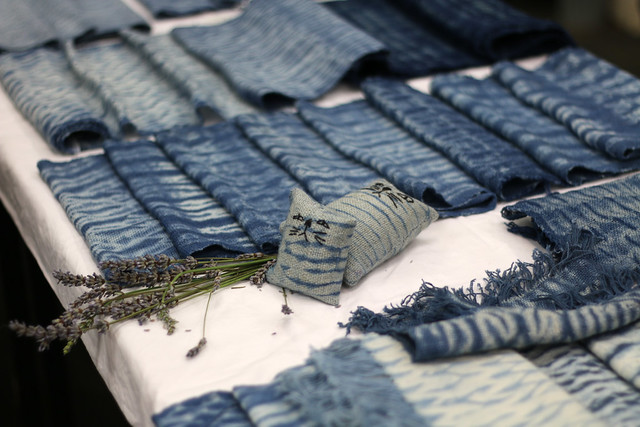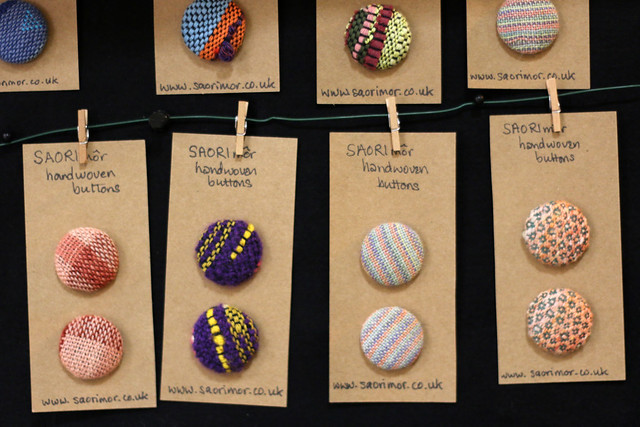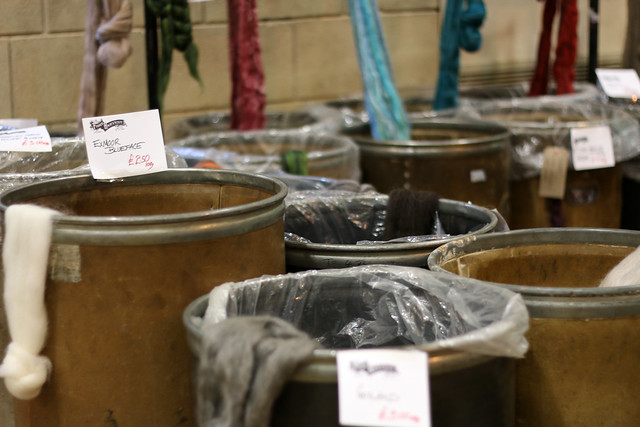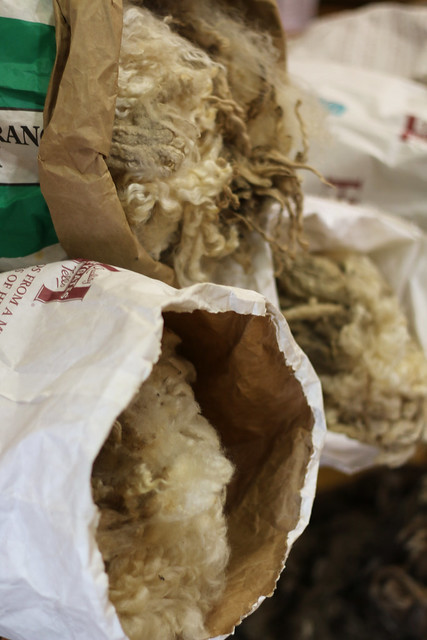As I’ve mentioned previously, I recently joined the Birmingham Guild of Weavers, Spinners and Dyers. Last week the Association of Guilds held their annual summer school. I didn’t attend the summer school, but I did attend the open day held last Saturday, where visitors could drop-in to shop at the trade fair and to view the work of summer school attendees.
The work on display included work by students on the Certificate of Achievement, which has been run by the Association since 1989, the syllabus of which includes weaving, tapestry weaving, spinning, natural dyeing, and synthetic dyeing.
Work by students of the summer school courses was also on display; the results of the shibori class are pictured below. I love the shibori cat lavender bags.
There were even more gorgeous things on display at the trade fair, and I did arrive home with a full shopping bag. I’ve listed a few of the vendors whose stalls I photographed below.
Beautiful weaving yarns from Weavers Bazaar
Garments and covered buttons woven by the three UK Saori weaving studios. Saori is a Japanese style of free-form weaving which I’d love to try.
Beautiful fibre, ready for spinning, from Hilltop Cloud.
Natural dye supplies and felt and slate buttons at Fiery Felts. I bought some ground madder which I’m looking forward to trying out for the first time soon.
Ceramic and wooden buttons and beads by Stitchwort Handmade, which is run by a member of my guild. I bought some white and blue ceramic buttons, which I have already put to use on my refashioners2015 project;)
Wool, fleece and knitted socks from the wonderful John Arbon Textiles, who operate out of a mill in Devon.
Textile Traders, based in Shropshire, who specialise in handmade fabrics from Asia. I bought a couple of small pieces of fabric which I’m planning to use to embellish garments – perhaps as a yoke or sleeves.
The Nepalese Textile Trust were selling textiles woven from the Himalayan giant nettle.
In addition to the main trade fair was a fleece fair run by the Rare Breeds Survival Trust, where I bought 1.5 kg of Blue Faced Leicester fleece.
My fleece is pictured below. It was recommended to me as a good choice for a newbie to carding and spinning. It could be a very long term project, but I’m excited about working through the various steps to turn this fleece into a finished garment. I’m not thinking about what finished garment it might become at this stage, as I want to see how I get on and how much usable yarn I can produce.
In order to turn this fleece into yarn there are quite a few steps that I need work through: washing, carding, spinning, dyeing (optional, I fancy dyeing it, but I’m also interested in seeing the natural blended colour I can achieve through carding and spinning ), and finally knitting. I’ll be blogging my progress as I go along.
I’ve made an initial start on washing the fleece. It’s not obligatory to wash a fleece before carding, but I didn’t fancy carding it without washing as I didn’t think it would be especially pleasant. The fleece was quite greasy (a mixture of lanolin and sweat), contained clumps of dirt (or worse…) and lots of twigs, and – unsurprisingly – smelled really strongly of sheep!
At the suggestion of a member of my Guild, I’ve tried a traditional method of washing fleece in rain water (known as the fermented suint method). The fleece needs to be left in rainwater in a covered contained for 5-7 days, ideally kept lukewarm. If the method works successfully a scum appears on the top of the bucket and it apparently smells very strongly of sheep. I’ve split my fleece between two buckets and popped them in the bottom of my grow-house, where they will hopefully get a bit of warmth. If I’ve had no luck in a week’s time (or if it comes out looking no cleaner than when it went in) I’ll try washing it with some gentle detergent instead, but I thought the traditional method was worth a try given how gloriously simple and natural it is. Wish me luck (and clean fleece)!



































